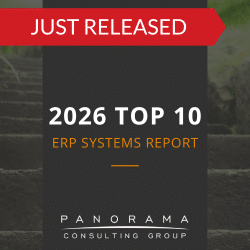Implementing an ERP system is one of the most significant investments your organization will make, both financially and strategically. Measuring its success, however, is notoriously complex.
Many companies rely on key performance indicators (KPIs) to gauge progress—but these metrics often give a false sense of security.
Today, we will explore the most common ERP KPI mistakes, the risks of relying on misleading ERP performance metrics, and how you can adopt more meaningful KPIs.
Why Traditional ERP Metrics Fall Short
1. Overemphasis on Implementation Timelines
Many organizations equate a “successful” ERP project with delivering it on time and within budget. While timelines are essential for project management, they tell you little about the long-term success of the ERP system.
Our ERP consultants will tell you that focusing too heavily on deadlines can encourage rushed decisions, compromising system configuration, user training, and change management efforts.
A system that launches on time but with poor user adoption or incorrect data structures is far from a success. CEOs and leadership teams should shift their perspective from “fast” implementation to “sustainable” transformation.
A Failed Payroll System Implementation
Panorama’s Expert Witness team was retained to provide a forensic analysis and written report to the court regarding the failed implementation of a major software developer’s ERP/payroll system.
2. Ignoring the Full Cost of Ownership
Tracking implementation costs alone ignores the long-term financial picture. ERP systems often incur post-launch expenses such as software upgrades, integration costs, and ongoing employee training. A narrow focus on initial budget adherence blinds companies to future expenditures.
Instead of focusing solely on budget targets, you need metrics that capture the total cost of ownership (TCO) over several years to understand the ERP’s real financial implications.
3. Misinterpreting User Adoption Metrics
Tracking login frequency or the number of users accessing the system is a common practice, but these are misleading ERP performance metrics. Employees may log into the system because it’s mandatory, not because they find it useful or effective.
What matters more is whether employees use the system correctly and if the ERP enables them to complete tasks more efficiently.
Most Misleading ERP Success Metrics
1. Go-Live Date as the Ultimate Milestone
The go-live date is often celebrated as the culmination of the ERP journey. However, treating it as the primary indicator of success ignores the reality that most ERP challenges arise post-launch. Inaccurate ERP success metrics like this can encourage leadership to declare victory prematurely.
Success in ERP isn’t about flipping the switch but about achieving stability, efficiency, and measurable improvements over time. A premature celebration of the go-live date can obscure lingering operational challenges that could jeopardize long-term outcomes.
2. System Uptime and Availability Rates
While system uptime is crucial from a technical standpoint, near-perfect availability doesn’t guarantee that the ERP is meeting your organization’s business needs. This common ERP KPI mistake may lead to complacency and mask underlying issues, such as poor user experience or inefficient workflows.
For example, an ERP system that’s 99.9% available but burdens employees with cumbersome processes adds no real value. What matters is not whether the system is “up” but how effectively it supports business operations.
3. On-Budget Implementation as a Success Metric
Completing an ERP project within the allocated budget is often viewed as a win. However, budget adherence doesn’t always reflect project success. Many organizations cut corners to stay within budget, which leads to costly adjustments post- go live.
What you really need are metrics that assess whether the project achieved the intended business outcomes and delivered the expected value, even if it entailed minor budget overruns.
4. KPIs with No Contextual Relevance
Some organizations rely on generic KPIs, such as “number of modules installed” or “transaction volumes processed.” These metrics may sound impressive, but without context, they offer little insight into the ERP’s real performance.
Leadership teams that prioritize accurate, context-specific metrics are better positioned to unlock the full potential of their ERP investment and avoid ERP failure.
Examples of such metrics include:
- Order fulfillment time
- Production cycle efficiency
- Patient care response time
- Claim processing speed
- Customer churn rate
In many cases, a consultant with software expert witness experience can provide additional assurance that your KPIs are aligned with industry standards—helping you avoid misleading ERP performance metrics and setting your organization on a path to long-term success.
The Risks of Using the Wrong Metrics
1. Strategic Misalignment and Missed Opportunities
Relying on inaccurate ERP success metrics can mislead leadership into thinking the system is delivering value when, in reality, it is underperforming. This disconnect between perceived success and actual performance often leads to missed opportunities for optimization.
Worse, it can delay necessary interventions, such as additional training or system upgrades.
Organizations should align their ERP metrics with broader business goals. An ERP system should be a tool for achieving strategic outcomes, not just an IT deliverable.
2. Employee Frustration and Productivity Loss
When misleading ERP performance metrics paint a picture of success, leadership may overlook operational challenges faced by employees. This creates a disconnect between management and end-users.
For example, employees may struggle with slow processes or a poorly configured system, even though leadership believes the ERP is working flawlessly based on technical metrics.
Addressing these issues early requires user-centric metrics, such as task completion times or error rates during transactions. If overlooked, unresolved issues may lead to burnout, reduced productivity, and even employee turnover.
3. Costly Course Corrections
ERP KPI mistakes can delay the discovery of critical problems. By the time leadership realizes that the ERP isn’t meeting expectations, the cost of corrective actions can be substantial.
Moreover, relying on inaccurate metrics can result in underfunded post-launch phases. Many organizations fail to allocate adequate budgets for continuous improvement because they assume the ERP is functioning well based on superficial metrics.
Better Metrics for Measuring ERP Success
1. Business Process Efficiency Improvements
Rather than focusing on system availability or logins, measure how effectively the ERP system improves your core business processes. Look at metrics such as:
- Order-to-cash cycle time: How quickly are invoices generated and payments collected?
- Inventory turnover: Is the ERP enabling better stock management and reducing overstock?
- Manufacturing lead time: Are production processes becoming more streamlined?
These metrics reflect how well the ERP integrates with and enhances your operations, providing more meaningful insights into success.
2. User-Centered Performance Metrics
Tracking how well users interact with the ERP system can provide early warning signs of potential problems. Examples include:
- Task completion time per user: Are employees completing their tasks faster post-ERP implementation?
- User error rates: Are there fewer data entry mistakes, or have errors increased due to poor training?
- Feedback from employee surveys: What do users say about the system’s usability and effectiveness?
These metrics shift the focus from raw usage to meaningful interaction, helping you identify areas where further training or system optimization is needed.
3. Long-Term Financial Performance Indicators
Short-term budget adherence is less important than the ERP’s contribution to long-term financial outcomes. Better metrics include:
- Return on Investment (ROI): Is the ERP driving revenue growth or cost savings that justify the investment?
- Cost per transaction: Has the ERP reduced the cost of processing orders or managing inventory?
- Profit margin improvement: Are you seeing an increase in profitability due to better operational efficiency?
These financial indicators align ERP performance with your company’s strategic financial goals, providing a clearer picture of success over time.
4. Change Management and Adoption Metrics
Since people are central to ERP success, it’s essential to measure the effectiveness of your change management efforts. Useful metrics include:
- Training effectiveness: Are employees applying what they learned, and are knowledge gaps being identified?
- Resistance levels: Are there pockets of resistance within the organization that need to be addressed?
- Adoption rates by department: Are all business units engaging with the system, or are some falling behind?
These metrics ensure that the human element of ERP adoption is not overlooked, helping you manage change proactively.
Avoid the Pitfalls of Misleading ERP Performance Metrics
Even the most well-designed ERP system can fall short if success metrics are poorly defined. By partnering with an experienced ERP consulting company and focusing on accurate, strategic KPIs, you can avoid the trap of misleading performance metrics and ensure your ERP investment delivers real, measurable value
Contact our business software experts for a free ERP consultation to learn more about effective ERP performance tracking and how our approach ensures sustainable business outcomes.















